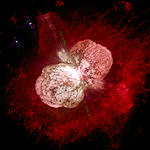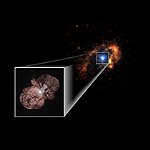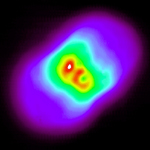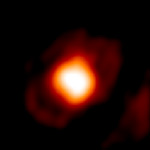CXC Home | Search | Help | Image Use Policy | Latest Images | Privacy | Accessibility | Glossary | Q&A
What Do These Images Tell Us?
Eta Carinae is one of the most famous and mysterious stars in our galaxy. Its mass has been estimated at 120 times the mass of the Sun, making it a good candidate for the most massive known star in our galaxy.
X-ray

Angular size of light blue cloud is approximately 8 arc seconds
Chandra's X-ray image of Eta Carinae reveals a hot inner core around this
mysterious superstar. The new X-ray observation shows three distinct structures:
an outer, horseshoe shaped ring about two light years in diameter, a hot
inner core about 3 light months in diameter, and a hot central source less
than a light month in diameter which may contain the superstar.
All three structures are thought to represent shock waves produced by matter rushing away from the superstar at supersonic speeds. The temperature of the shock-heated gas ranges from 60 million degrees Celsius in the central regions to 3 million degrees Celsius on the outer edge.
All three structures are thought to represent shock waves produced by matter rushing away from the superstar at supersonic speeds. The temperature of the shock-heated gas ranges from 60 million degrees Celsius in the central regions to 3 million degrees Celsius on the outer edge.
Optical

JAngular size of bipolar nebula = 18 arc seconds
The optical image of Eta Carinae's made by the Hubble Space Telescope reveals
two spectacular bubbles of gas expanding in opposite directions away from
a central bright region at speeds in excess of a million miles per hour.
The inner region visible in the Chandra image has never been resolved before,
and appears to be associated with a central disk of high velocity gas rushing
out at much higher speeds perpendicular to the bipolar optical nebula.

Inset box = 20 arc seconds on a side
NASA/CXC/SAO/HST
The inset box with the optical image of Eta Carinae illustrates its location relative to the inner region of the X-ray image.
Download:
Infrared

18 micron IR image. Angular size of nebula is approximately 18 arc seconds
Eta Carinae is also the most luminous known star in our galaxy. It radiates
energy at a rate that is 5 million times that of the Sun. Most of this energy
is radiated at infrared wavelengths. It is shrouded in a rapidly expanding
cloud of dust which absorbs radiation from the central star and re-radiates
it in the infrared.
Radio

Angular size of nebula is approximately 18 arc seconds
This radio image of Eta Carinae (frequency = 5 Ghz) shows much the same
overall structure as the optical image. The bright feature at the center
of the radio image is where the star is: the emission here is effectively
"burnt out". In recent years Eta Carinae has undergone a radio outburst
which makes it one of the brightest radio stars in the sky.
Return to Eta Carinae (08 Oct 99)


